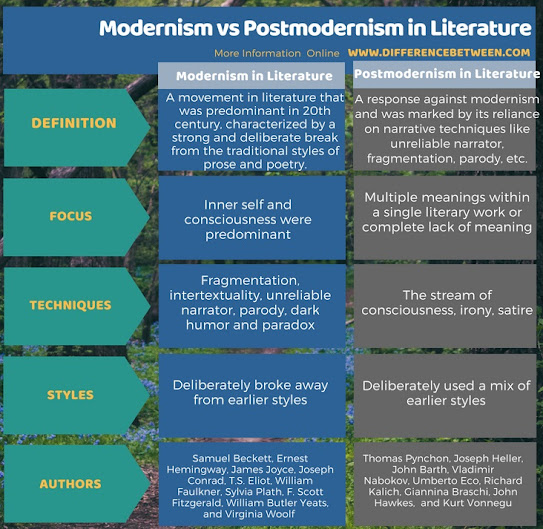 |
| La Pastiche |
No doubt, before an idea of the postmodernism there was another supposed the Modernism. It came into existence to the fashionable period combined with manufacture, market-oriented capitalist economies, new social categories, democracy, and Enlightenment values- ”reason and progress”. This controversial philosophy, the philosophy of the Enlightenment, it's attainable that ”the institution of objective facts and universal values.”Post modernism broadly refers to a socio cultural and literary theory and a shift in perspective in a a variety of disciplines like social science, art, architecture, literature, fashion, communication etc. It is believed to have began in some 1950s. Work were decentred which did not portray any goal in life but merely represented an age of civilisation.
Similarities between Modernism and Post Modernism
Post modernism is at once a continuation of and a break away from the modernist stance. Both reject rigid boundaries between high and low art as well as reflect the insecurities, disorientation, and fragmentation of the 20th century. Both modernism and post modernism were greatly influenced by events like world wars, industrialization, and urbanization. Both employ pastiche, i.e., imitation of another's style. Pastiche and parody serve to remind the reader that the work is fictional and constructed.
Differences between Modernism and Post Modernism
Though the works are fragmented modernism laments for the loss of the past whereas, post modernism celebrates the same. Modernism is a development in writing that was dominating in the twentieth century, described by a solid and conscious break from the conventional styles of exposition and verse. Conversely, postmodernism was a reaction against modernism and was set apart by its dependence on story strategies like unreliable narrator, fragmentation, parody etc. So forth Samuel Beckett, Ernest Hemingway, James Joyce, Joseph Conrad, T.S. Eliot, William Faulkner, Sylvia Plath, F. Scott Fitzgerald, William Butler Yeats, and Virginia Woolf are a few instances of modernist writers. Thomas Pynchon, Joseph Heller, John Barth, Vladimir Nabokov, Umberto Eco, Richard Kalich, Giannina Braschi, John Hawkes, and Kurt Vonnegu are a few instances of postmodernist creators.
Modernist writers purposely split away from customary styles of composing and focused on internal identity and cognizance in their compositions. The stream of consciousness was the significant strategy presented during this development. Be that as it may, postmodernist writers intentionally utilized a combination of earlier styles. They additionally utilized methods like fragmentation, intertextuality, unreliable narrator, dark humor and paradox. This is the primary contrast between modernism and postmodernism in writing. Modernist writers believed in coherence and unity and emphasised the importance of rationality and order. In modernist view:
More rationality would bring more order which would further bring better society.
Post modernism criticised binary oppositions cynically and believed everything to be a disorder. In post modernism there are no depths but only surfaces. Post modernist writers deconstruct and question the orders which modernists believed would bring stability and unity.
Some Examples of Post Modern Novels
- One Hundred Years of Solitude by Gabriel García Márquez
- Catch-22 by Joseph Heller
- Gravity’s Rainbow by Thomas Pynchon
- Naked Lunch by William S. Burroughs
- Infinite Jest by David Foster Wallace
- The Crying of Lot 49 by Thomas Pynchon
Some common literary techniques in postmodernism are as follows:
Pastiche – taking various ideas from previous work and styles and pasting them together to create a new story
Temporal distortion – non-linear timeline and fragmented narrative
Metafiction – Making readers aware of the fictional nature of the text they are reading
Intertextuality – acknowledging previous literary works within a literary work
Magical Realism – incorporating magical or unrealistic events into a realistic story
Maximalism – highly detailed, disorganized and long writing
Minimalism – using common and non-exceptional characters and events















0 comments:
Post a Comment